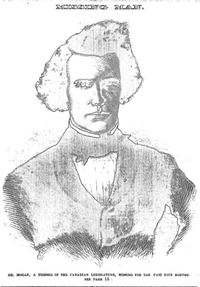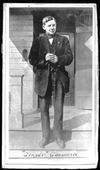
Source: Link
HOGAN, JOHN SHERIDAN, printer, newspaperman, lawyer, and politician; b. c. 1815 near Dublin; d. 1 Dec. 1859 in Toronto.
Son of a hospitable but poverty-ridden family, John Sheridan Hogan came to York (Toronto) to live with an uncle in 1827. He ran away to Hamilton, where he worked successively as newsboy, printer, foreman, and writer on A. K. Mackenzie’s Canadian Wesleyan which was published from 1831 to about 1835. Hogan probably had little formal education, although he convinced Samuel Thompson*, who later employed him, that he had “distinguished himself at college.” By 1837 he was working in the law office of Allan Napier MacNab*, and on 29 Dec. 1837 was involved with his employer in the burning of the Patriot supply ship Caroline. Nevertheless, after the acquittal of Alexander McLeod*, who had been tried in October 1841 for his involvement in the Caroline affair, Hogan was a key figure in an attempt to keep the Patriot flame alive. Early in 1842, following a plan by his former employer A. K. Mackenzie, Hogan agreed to enter the United States and have himself arrested for harming American citizens during the Caroline affair. The intention was to stir up hostilities between the Canadian and American governments and thus aid the Patriot cause. He did cross the border and was arrested in Lockport, N.Y.; however, the warrant against him was found to have been made out improperly and, on the advice of William Lyon Mackenzie* (who had opposed the scheme), he returned to Canada. But Mackenzie soon changed his mind and another attempt was arranged. Mackenzie had Edward Alexander Theller arrest Hogan in Rochester on 31 March but once more the court decided that it could not properly try him. At this point, in the face of growing cordiality between the two countries following the arrival in April of Lord Ashburton, who defused the situation diplomatically, the affair petered out entirely. The motives and actions of both Hogan and A. K. Mackenzie are not clearly understood and some historians have suggested that they may have been serving the loyal faction as double agents.
In the late 1830s Hogan had suspended his law studies and in 1840 had become clerk and bookkeeper to Allan Macdonell*, sheriff of the Gore District. In 1841, however, he returned to a Hamilton law office and was called to the bar two years later. By 1849 he had shifted to political journalism and was parliamentary correspondent for several journals, developing a “bold, bitter, and unsparing style.” His strength as a political writer appears in three able articles published in Blackwood’s Edinburgh Magazine in 1849–50, two entitled “Civil revolution in the Canadas” and one “Civil revolution in the Canadas – a remedy.” He argued that, as a British colony, Canada could exceed the United States as a field for British development but that want of internal accord was destroying the confidence of British capitalists in Canadian capabilities. The articles were reprinted and circulated in London and were widely referred to in Canadian newspapers. In 1850 Blackwood’s had also published Hogan’s New Year’s poem “Canadian loyalty.” Two years later he was associated with Samuel Thompson in establishing the United Empire, a semi-weekly journal published in Toronto. The United Empire attacked Francis Hincks* for pro-American sympathies, commented on the clergy reserves question, and urged the British to grant the colonies representation in the imperial parliament. Curiously, in view of Hogan’s death, the 19 June 1852 edition contained, along with a rich mixture of economic and political comment, two items on drownings and a court report of the trial of one James Brown who was charged by his mother with beating his sister. Hogan had presented his ideas on politics and economics in more permanent form the previous month in his essay The Canadas. Using statistics showing trade with Britain declining, he concluded that free trade was disastrous for the Upper Canadian farmer. British garrisons appeared as “the last remains of expensive furniture in a ruined house.”
After Thompson bought the Daily Colonist in 1853, Hogan moved to that paper, as assistant editor and Quebec correspondent, and took up cudgels against Hincks and his “crop of corruption,” while continuing to report and comment on sensational murders as well as politics. The Colonist, which according to Thompson was “an exact counterpart of the London Times in typographical appearance, size of page and type, style of advertisements, and above all, in independence of editorial comment and fairness in its treatment of opponents,” eventually claimed a weekly circulation of 30,000. In 1854 Hogan decided to enter politics but, running as a moderate reformer for the York East seat in the Legislative Assembly, he was defeated by Amos Wright*, an ultra reformer.
Hogan pulled his ideas together the following year in an essay submitted to the contest for the universal exposition in Paris; it won first prize and was published by order of the government in both English and French. A history of the two Canadas, it traces the rise of towns, self-government, and capital, all in relation to trade, banking, immigration, and education. Sober statistics are converted into a panegyric on a land of “quiet plenty” and the essay is an important reflection of mid-19th-century assumptions about progress through industrial development. It included a detailed map of railway development in Canada and the northern United States, reflecting an interest shared with his old colleague MacNab.
In 1856 Hogan became editor-in-chief of the Daily Colonist but the following year he left the paper to run again for parliament and this time he was elected for Grey. He was regarded, with Oliver Mowat* and Thomas D’Arcy McGee*, as one of the coming men among the new members. Tall, spare, and agile, he was admired for his writing and wit, and respected for his independence. Hogan, an Independent Liberal, voted against the ephemeral Liberal ministry of George Brown* and Antoine-Aimé Dorion* on 2 Aug. 1858, though he “continued to favour the Liberal side of questions.” When John A. Macdonald*, whom Hogan had admired as a young politician, and George-Étienne Cartier* returned to power that same month, he did not hesitate to attack their ministry. Active involvement in politics had not, however, ended his writing, and a political pamphlet appeared in November 1859.
Then, as December 1859 began, he disappeared. Although he had married Madeline Wharton Metcalf at Christ’s Church (Anglican) in Hamilton on 18 Nov. 1847, he apparently was living alone at this time. He resided at Toronto’s Rossin House hotel and intermittently supported a Mrs Laurie and her children. His movements were often erratic and his absence caused no alarm for two months, when an unsuccessful search for him was launched in the United States. More than 16 months after his disappearance, his body was found in Toronto’s Don River. A police informer said she had seen Hogan attacked and robbed by James Brown, Jane Ward, John Sherrick, and two other members of the notorious “Brooks’ Bush Gang,” terrorizers of east end citizenry. The melodramatic trial of Ward and Sherrick revealed that Hogan had left Mrs Laurie on 1 Dec. 1859, stopped in at the Colonist office, and then proceeded east on the Kingston road. Flashing an unusually large roll of money on the Don bridge, Hogan was beaten when he offered to pay a usual “toll” to the gang members. Unfortunately he recognized one of the attackers, whom he called by name, whereupon a member of the gang “put a stone in a handkerchief and brained him.” Ward and Sherrick were acquitted but at a later trial James Brown, though he swore his innocence to the end, was convicted; despite a retrial, he was executed at a public hanging on 10 March 1862.
Ardent and loyal yet reform-minded, Hogan had in his life as a journalist and politician helped direct Canadian hopes of maintaining, while liberalizing, the British connection. Like McGee, he contributed a controversial note to political and literary life in the 1840s and 1850s but, unlike his distinguished compatriot, he was murdered not by a political assassin but by a gang of roughnecks. His death, like the minor columns of his papers, revealed the seamy life on the edges of Toronto society in the mid 19th century.
John Sheridan Hogan is the author of The Canadas: shall they “be lost or given away?” A question to be decided by the people of England in choosing between free trade or protection; an essay . . . (Toronto, 1852); Canada: an essay: to which was awarded the first prize by the Paris Exhibition Committee of Canada (Montreal, 1855), which was also published as Le Canada: essai auquel le premier prix a été adjugé par le Comité canadien de l’Exposition de Paris (Montréal, 1855); and A review of the proceedings of the Reform Convention, held in the St. Lawrence Hall, Toronto, 9th November, 1859 . . . (Toronto, 1859). Hogan published anonymously in Blackwood’s Edinburgh Magazine (Edinburgh and London) a series of articles entitled “Civil revolution in the Canadas,” 65 (January-June 1849): 727–41 and 67 (January–June 1850): 249–68, and “Civil revolution in the Canadas – a remedy,” 66 (July–December 1849): 471–85. Hogan’s poem, “Canadian loyalty: an ode, written at sunrise on New-Year’s morning of 1850, at the head of Lake Ontario, in western Canada,” was published anonymously in Blackwood’s Edinburgh Magazine, 67: 345–46.
AO, MS 516, 15 Feb.–18 April 1842. British Colonist (Toronto), 1849–50. Daily Colonist (Toronto), 1851–58. United Empire (Toronto), 1852–53. Marriage notices of Ontario, comp. W. D. Reid (Lambertville, N.J., 1980), 214. Morgan, Bibliotheca Canadensis, 192; Sketches of celebrated Canadians, 764–65. Cornell, Alignment of political groups, 37, 45, 48. L. F. [Cowdell] Gates, William Lyon Mackenzie: the post-rebellion years in the United States and Canada (Ithaca, N.Y., 1978). N. F. Davin, The Irishman in Canada (London and Toronto, 1877), 645–51. L. S. Fallis, “The idea of progress in the Province of Canada: a study in the history of ideas,” The shield of Achilles: aspects of Canada in the Victorian age, ed. W. L. Morton (Toronto and Montreal, 1968), 169–83. Guillet, Lives and times of Patriots; Toronto from trading post to great city (Toronto, 1934), 224–25. O. A. Kinchen, The rise and fall of the Patriot hunters (New York, 1956). Samuel Thompson, Reminiscences of a Canadian pioneer for the last fifty years: an autobiography (Toronto, 1884; repub. Toronto and Montreal, 1968). W. S. Wallace, Murders and mysteries; a Canadian series (Toronto, 1931), 255–71; “The periodical literature of Upper Canada,” CHR, 12 (1931): 4–22.
© 1985–2024 University of Toronto/Université Laval
Image Gallery

Cite This Article
Elizabeth Waterston, “HOGAN, JOHN SHERIDAN,” in Dictionary of Canadian Biography, vol. 8, University of Toronto/Université Laval, 2003–, accessed May 10, 2024, http://www.biographi.ca/en/bio/hogan_john_sheridan_8E.html.
The citation above shows the format for footnotes and endnotes according to the Chicago manual of style (16th edition). Information to be used in other citation formats:
| Permalink: | http://www.biographi.ca/en/bio/hogan_john_sheridan_8E.html |
| Author of Article: | Elizabeth Waterston |
| Title of Article: | HOGAN, JOHN SHERIDAN |
| Publication Name: | Dictionary of Canadian Biography, vol. 8 |
| Publisher: | University of Toronto/Université Laval |
| Year of publication: | 1985 |
| Year of revision: | 1985 |
| Access Date: | May 10, 2024 |

















